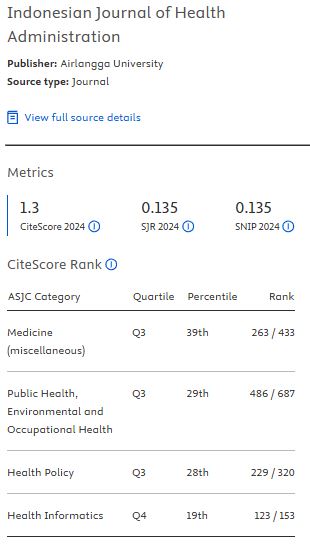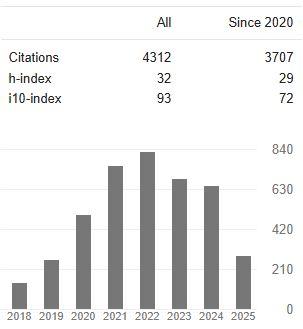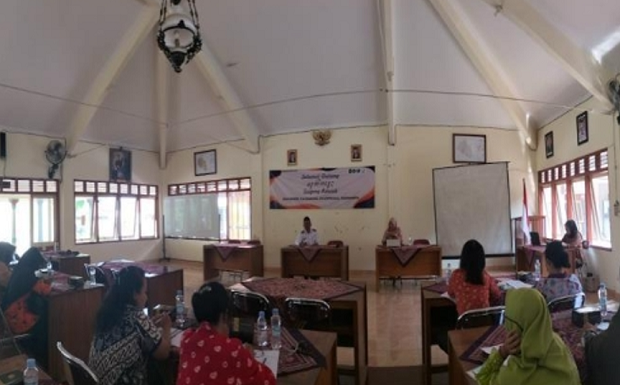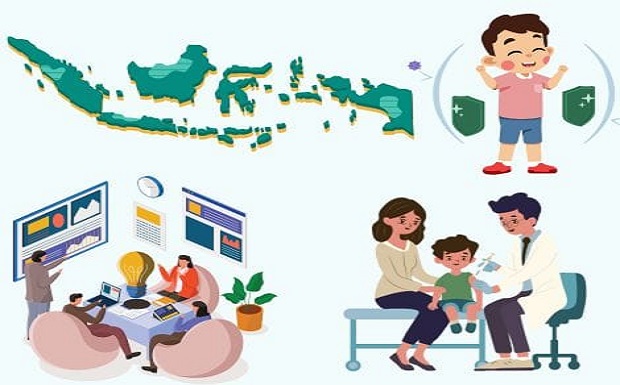COMMUNICATION OF PROFESSIONAL CAREGIVERS IN ESTABLISHING INTERPROFESSIONAL COLLABORATION AT MEURAXA HOSPITAL, BANDA ACEH
Downloads
Background: Interprofessional collaboration for patient care is integrated cooperation between health workers in ensuring optimally consecutive patient care. Interprofessional decisions should be made in two ways between professional caregivers.
Aims: This study aimed to analyze communication between professional caregivers in establishing interprofessional collaboration at Meuraxa District General Hospital in Banda Aceh.
Method: This study was qualitative research and used a phenomenological approach. In-depth interviews and FGD were conducted with professional caregivers consisting of doctors in charge, nurses, pharmacists, and dietitians. All of the in-depth interviews and FGD were recorded and transcribed. Data obtained were analyzed thematically.
Results: Communication between professional caregivers in establishing interprofessional collaboration at the hospital had not been well-performed. Overall, they had not optimally utilized integrated patient progress records as they focused on taking care of their patients individually. They also lacked literacy about the information in the records. Inadequate time in serving patients and the insufficient number of human resources were presumed to hamper interprofessional communication.
Conclusion: Promoting interprofessional collaboration and effective communication regularly is required by the hospital management. They also need to evaluate the sufficiency of human resources, especially pharmacist positions. Besides, they can formulate supervision and evaluation systems of interprofessional communication between professional caregivers.
Keywords : communication, integrated patient progress record, interprofessional collaboration, professional caregivers
Agusrianti, P. (2015). Analisis Faktor-Faktor yang Berhubungan dengan Efektivitas Komunikasi Perawat dan Pasien di Ruang Rawat Inap Rumah Sakit Harapan Mulia Kabupaten Bekasi Tahun 2015. Jurnal Administrasi Rumah Sakit, 2(1), 72-83.
Callinan, S., & Brandt, N. (2015). Tracling Communication Barriers Between Long-Term Care Facility and Emergency Departement Transfers to Improve Medication Safety in Older Adult. Journal of Gerontological Nursing, 41(7), 8-13.
Canadian Interprofessional Health Collaborative. (2010). A National Interprofessional Competency Framework. Vancouver, BC, Canada: Canadian Interprofessional Health Collaborative.
Canadian Interprofessional Health Collaborative. (2012). An Inventory of Quantitative Tools Measuring Interprofessional Education and Collaborative Practice Outcomes. Canada: Canadian Interprofessional Collaboration Health Collaborative.
Fatalina, F., Sunartini, Widyandana, & Sedyowinarso, M. (2018). Persepsi dan Penerimaan Interprofessional Collaboration Practice Bidang Maternitas pada Tenaga Kesehatan. Jurnal Pendidikan Kedokteran Indonesia, 4(1), 28-36.
Hardin. (2019). Faktor-Faktor yang Berhubungan dengan Praktik Kolaborasi Perawat- Dokter di RSUD Sawerigading Palopo dan RSUD Andi Djemma Masamba. Jurnal Fenomena Kesehatan, 2(1), 155-164.
Hartana, I. (2016). Komunikasi yang Efektif. Retrieved 2020, from I-Care Institute: https://ot.id/tips-profesional/komunikasi-yang-efektif
Interprofessional Education Collaborative Expert Panel. (2011). Core competencies for interprofessional collaborative practice : Report of an expert panel. Washington, D.C: Interprofessional Education Collaborative.
Kementerian Kesehatan RI. (2017). Peraturan Menteri Kesehatan Republik Indonesia Nomor 11 Tahun 2017. Retrieved September 25, 2020, from Biro Hukum dan Organisasi Kementerian Kesehatan Republik Indonesia: http://hukor.kemkes.go.id/hukor/search
Komisi Akreditasi Rumah Sakit. (2017). Standar Nasional Akreditasi Rumah Sakit (I ed.). (P. H. Garna, Ed.) Jakarta Selatan, Indonesia: Komisi Akreditasi Rumah Sakit (KARS).
Kusumaningrum, P., Dharmana, E., & Sulisno, M. (2018). The Implementation of Integrated Patient Progress Notes in Interprofessional Collaborative Practice. Jurnal Ners dan Kebidanan Indonesia, 6(1), 32-41.
Larasati, T. A. (2019). Komunikasi Dokter-Pasien Berfokus Pasien pada Pelayanan Kesehatan Primer. Jurnal Kedokteran Universitas Lampung, 3(1), 160-166.
Lestari, Y., Ariyanti, S., & Pasinringi, S. (2017). Hubungan Interprofesional Kolaborasi dengan Pelaksanaan Catatan Perkembangan Pasien Terintegrasi di RSUD. Prof. DR. H.M. Anwar Makkatutu Kabupaten Bantaeng. JST Kesehatan, 7(1), 85-90.
Nazri, F., Juhariah, S., & Arif, M. (2015). Implementasi Komunikasi Efektif Perawat-Dokter dengan Telepon di Ruang ICU Rumah Sakit Wava Husada. Jurnal Kedokteran Brawijaya, 28(2), 174-180.
Norouzinia, R., Aghabarari, M., Shiri, M., Karimi, & Samami, E. (2016). Communication Barriers Perceived by Nurses and Patients. Global Journal of Health Science, 8(6), 65-74.
Reeves, S., Pelone, F., Harrison, R., Goldman, J., & Zwarenstein, M. (2017). Interventions to Improve Professional Practice and Healthcare Outcomes (Review). Cochrane Database Systematic Reviews(6), 11-12.
Ridar, I., & Santoso, A. (2018). Peningkatan Komunikasi dalam Pelaksanaan Interprofessional Collaboration melalui Catatan Perkembangan Pasien Terintegrasi. Prosiding Seminar Nasional Unimus, 1, 144-149.
Rokhmah, N. A., & Anggorowati. (2017). Komunikasi Efektif dalam Praktek Kolaborasi Interprofesi Sebagai Upaya Meningkatkan Kualitas Pelayanan. Journal of Health Studies, 1(1), 65-71.
RSUD Meuraxa . (2019). Panduan Pelaksanaan Komunikasi Efektif.
Setiadi, A., Wibowo, Y., Herawati, F., Irawati, S., Setiawan, E., Presley, B., et al. (2017). Factors Contributing to Interprofessional Collaboration in Indonesian Health Centres: A Focus Group Study. Journal of Interprofessional Education & Practice, 8, 69-74.
Susilaningsih, F., Mediani, H., Kurniawan, T., Widiawati, M., Maryani, L., & Meharawati, I. (2017). Sosialisasi Model Praktik Kolaborasi Interprofesional Pelayanan Kesehatan di Rumah Sakit. Jurnal Aplikasi Ipteks untuk Masyarakat, 6(1), 10-13.
Syahrizal, D., Renaldi, T., Dianti, S., Jannah, N., Rachmah, R., Firdausa, S., et al. (2020). The Differences in Perceptions of Interprofessional Education Among Health Profession Students: The Indonesian Experience. Journal of Multidisciplinary Healthcare, 13, 403-410.
Utami, L. C. (2018). Gambaran Sikap Kolaborasi Interprofesi Perawat-Dokter di Instalasi Rawat InapRSD dr. Soebandi Jember. Universitas Jember, Program Studi Sarjana Keperawatan Fakultas Keperawatan. Jember: Digital Repository Universitas Jember.
World Health Organization. (2010). Framework for Action on Interproffessional Education and Collaborative Practice. Geneva 27, Switzerland: World Health Organization Press/Health Professions Networks/ Nursing & Midwifery/ Human Resources for Health.
Copyright (c) 2021 Sri Wahyuni, Nova Dian Lestari, Dedy Syahrizal

This work is licensed under a Creative Commons Attribution-ShareAlike 4.0 International License.
1. As an author you (or your employer or institution) may do the following:
- make copies (print or electronic) of the article for your own personal use, including for your own classroom teaching use;
- make copies and distribute such copies (including through e-mail) of the article to research colleagues, for the personal use by such colleagues (but not commercially or systematically, e.g. via an e-mail list or list server);
- present the article at a meeting or conference and to distribute copies of the article to the delegates attending such meeting;
- for your employer, if the article is a ‘work for hire', made within the scope of your employment, your employer may use all or part of the information in the article for other intra-company use (e.g. training);
- retain patent and trademark rights and rights to any process, procedure, or article of manufacture described in the article;
- include the article in full or in part in a thesis or dissertation (provided that this is not to be published commercially);
- use the article or any part thereof in a printed compilation of your works, such as collected writings or lecture notes (subsequent to publication of the article in the journal); and prepare other derivative works, to extend the article into book-length form, or to otherwise re-use portions or excerpts in other works, with full acknowledgement of its original publication in the journal;
- may reproduce or authorize others to reproduce the article, material extracted from the article, or derivative works for the author's personal use or for company use, provided that the source and the copyright notice are indicated.
All copies, print or electronic, or other use of the paper or article must include the appropriate bibliographic citation for the article's publication in the journal.
2. Requests from third parties
Although authors are permitted to re-use all or portions of the article in other works, this does not include granting third-party requests for reprinting, republishing, or other types of re-use.
3. Author Online Use
- Personal Servers. Authors and/or their employers shall have the right to post the accepted version of articles pre-print version of the article, or revised personal version of the final text of the article (to reflect changes made in the peer review and editing process) on their own personal servers or the servers of their institutions or employers without permission from JAKI;
- Classroom or Internal Training Use. An author is expressly permitted to post any portion of the accepted version of his/her own articles on the author's personal web site or the servers of the author's institution or company in connection with the author's teaching, training, or work responsibilities, provided that the appropriate copyright, credit, and reuse notices appear prominently with the posted material. Examples of permitted uses are lecture materials, course packs, e-reserves, conference presentations, or in-house training courses;























